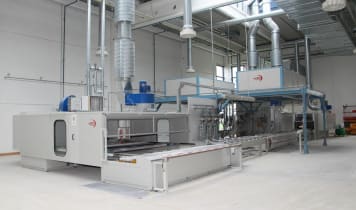Surface treatment of metals can be sub-divided into three areas:
- Finishing
- Coating
- Changing substance properties
There may be several applications that can be used in conjunction with each other depending on product and metal variety.
Finishing
Finishing means treating a surface before the metal product passes through another machining process, or prior to its completion as a product. Finishing is the last stage that acts directly on the workpiece by removing extraneous outer layers of material. The following applications are available for finishing:
- Cutting
- Grinding
- Polishing and lapping
- Blasting and cleaning
Cutting
Many metal products will already have been completed on a lathe or mill. Any further intervention will only worsen its material properties. This particularly applies to many technical components.
Grinding
If a cutting process is not precise enough, a grinding machine can be used to remove outer layers of material until the desired dimensions have been attained.
Polishing and lapping
Polishing and lapping can be used to provide a glossy surface as well precisely determine the shape down to a thousandth of a millimetre. Polishing is also a key step to be performed prior to chrome-plating and centrifugal finishers are often used for this purpose. They facilitate the efficient polishing of small parts without requiring any manual work.
Blasting and cleaning
Blasting is a method of wearing down large-scale surfaces. If an abrasive medium is used, material loss will always be entailed but this method is without alternative if a metallic object’s surface has been damaged: it is difficult to prepare corrosion-scarred surfaces for a new coating in any other way.
Other blasting methods may come into play depending on the base material, such as:
- Sand, quartz or corundum, which will make easy work of thick sheet metal or bulky cast-metal parts.
- For thin sheet metal, such as car chassis, baking powder is generally used.
In addition to blasting machines using abrasive media, there are also abrasion-free blasting methods: high-pressure water jets, for example, which use a concentrated blast of water. Such an approach is capable of removing the paint from an entire car within just a few minutes, but it involves a very complex technique.
The fastest-growing typed of blasting machine and cleaning system are dry-ice blasters. These work with pellets made from frozen carbon dioxide and achieve the very best cleaning results without any damage to surfaces. Other types of cleaning systems include conventional rinsing plants that work using soap- or alcohol-based cleaning agents. They are also used for removing grease and paint.
Galvanising machines for a perfect finish
Chrome-plating is the most advanced type of metal surface treatment. Galvanising machines may be simple on a technical level, but the products must be put through a long and complicated preparation process. Chrome-plated metallic products are well-protected against corrosion and attain a beautiful, glossy finish. But for those simply looking for sustainable protection against rust, zinc-coating machines are the most widespread type of galvanising plant for metallic products. They cover the surfaces with a hard, thick layer or rust-proof zinc which is not very visually appealing, but it means the items are well-prepared for further coating.
Coating
Painting, powder-coating and adhesion for visual appeal
Transforming a metallic item into a visually appealing product requires one final surface finishing step: coating. This involves the use of painting systems, powder-coating machines, or glue stations. The technologies available today enable operators to apply any type of coating while maintaining high productivity and consistent quality.
Changing substance properties
Making metals more resilient through surface treatment
Hardening methods are used to make a technically hard-wearing but difficult-to-access product more resilient. The most widespread application is hardening gear units. This process starts with gear that has been fully cut and ground down to the right dimensions that is then heated until it is red-hot and subsequently cooled off in an oil bath. This hardens the product surface while keeping the interior of the gear soft and elastic. This achieves abrasion-resistant surfaces and inner workings that can react elastically to high loads.



















































